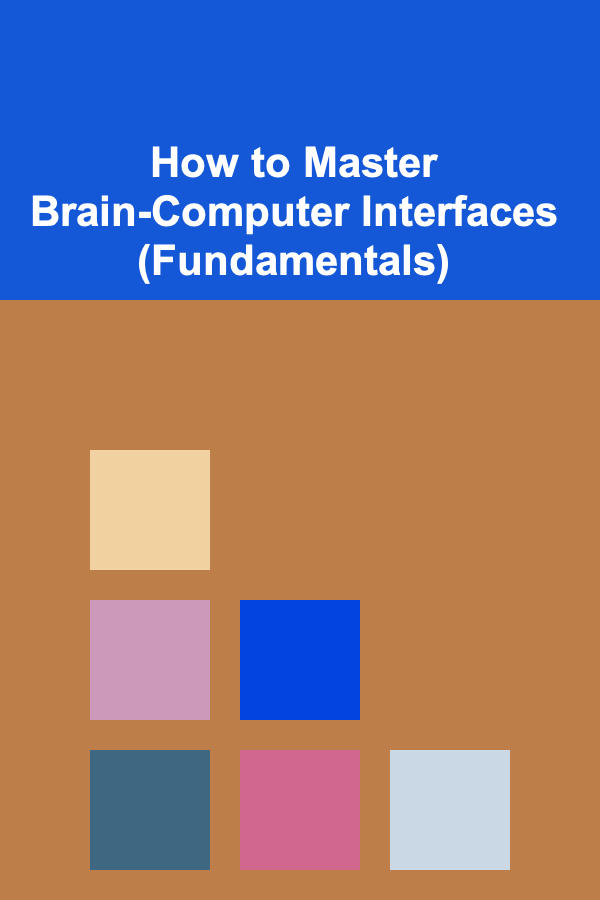
How to Master Brain-Computer Interfaces (Fundamentals)
ebook include PDF & Audio bundle (Micro Guide)
$12.99$6.99
Limited Time Offer! Order within the next:

Brain-Computer Interfaces (BCIs), sometimes referred to as Brain-Machine Interfaces (BMIs), represent a revolutionary field at the intersection of neuroscience, engineering, and computer science. They offer the potential to directly translate brain activity into commands that control external devices or restore lost motor functions, offering unprecedented opportunities for individuals with disabilities and opening new frontiers in human-computer interaction.
Mastering BCIs requires a multidisciplinary approach, encompassing a deep understanding of neurophysiology, signal processing, machine learning, and hardware design. This article provides a comprehensive overview of the fundamental concepts and skills necessary to embark on a journey towards mastering this complex and fascinating field. It aims to guide you through the key areas of knowledge and practical skills that are essential for building and utilizing BCI systems.
I. Understanding the Human Brain: Neurophysiology Fundamentals
The foundation of any BCI system lies in understanding the signals it aims to interpret -- the electrical activity of the brain. A solid grasp of neurophysiology is therefore paramount.
A. Neurons and Neural Communication
The brain is composed of billions of neurons, the fundamental units of the nervous system. These cells communicate through electrochemical signals. Understanding the following concepts is crucial:
- Neuron Structure: Dendrites (receiving signals), cell body (integrating signals), axon (transmitting signals), and synapses (connections to other neurons).
- Action Potentials: The all-or-nothing electrical signal that travels down the axon, enabling long-distance communication. Understand the phases: depolarization, repolarization, and hyperpolarization.
- Synaptic Transmission: The process by which signals are transmitted between neurons across the synapse using neurotransmitters. Learn about different types of neurotransmitters (e.g., glutamate, GABA) and their effects (excitatory or inhibitory).
- Neural Networks: How neurons are interconnected to form complex circuits that process information. Understand basic network motifs like feedforward and feedback loops.
B. Brain Regions and Their Functions
Different regions of the brain specialize in different functions. Knowing these regions and their roles is vital for designing BCIs that target specific cognitive processes or motor functions.
- Cerebral Cortex: The outer layer of the brain responsible for higher-level cognitive functions. Key areas include:
- Motor Cortex: Controls voluntary movements.
- Somatosensory Cortex: Processes sensory information from the body.
- Visual Cortex: Processes visual information.
- Auditory Cortex: Processes auditory information.
- Prefrontal Cortex: Involved in executive functions, planning, and decision-making.
- Subcortical Structures: Regions beneath the cortex that play crucial roles in motor control, emotion, and memory. Examples include:
- Basal Ganglia: Involved in motor control and reward learning.
- Thalamus: Relays sensory information to the cortex.
- Hippocampus: Involved in memory formation.
- Amygdala: Involved in emotional processing.
- Cerebellum: Coordinates movement and balance.
C. Neural Oscillations and Event-Related Potentials (ERPs)
Brain activity is characterized by rhythmic electrical oscillations and transient voltage changes in response to specific events. Understanding these phenomena is crucial for BCI design.
- Neural Oscillations (Brainwaves): Rhythmic patterns of electrical activity that reflect different brain states. Common frequency bands include:
- Delta (1-4 Hz): Deep sleep.
- Theta (4-8 Hz): Drowsiness, meditation.
- Alpha (8-13 Hz): Relaxed wakefulness, eyes closed.
- Beta (13-30 Hz): Active thinking, concentration.
- Gamma (30-100 Hz): Cognitive processing, attention.
- Event-Related Potentials (ERPs): Averaged brain responses to specific stimuli or events. Common ERP components include:
- P300: A positive voltage deflection that occurs around 300 milliseconds after a rare or salient stimulus.
- N400: A negative voltage deflection that occurs around 400 milliseconds after a semantically incongruent word.
- Error-Related Negativity (ERN): A negative voltage deflection that occurs immediately after an error.
D. Ethical Considerations
As BCIs directly interface with the brain, they raise significant ethical concerns. Understanding these issues is crucial for responsible BCI development and application.
- Privacy: BCIs can potentially reveal sensitive information about a person's thoughts, emotions, and intentions. Data security and privacy protection are paramount.
- Autonomy: BCIs can potentially be used to control or influence a person's behavior. Protecting individual autonomy and freedom of choice is essential.
- Agency: If a BCI user's actions are controlled by the device, who is responsible for the consequences? Establishing clear lines of responsibility is crucial.
- Equity: BCI technology may be expensive and inaccessible to everyone. Ensuring equitable access to this technology is important.
- Security: BCIs can be vulnerable to hacking and manipulation. Robust security measures are needed to protect against unauthorized access and control.
II. Signal Acquisition: Translating Brain Activity
The next crucial step is acquiring the brain signals and converting them into a format suitable for processing. Several techniques exist, each with its own advantages and limitations.
A. Electroencephalography (EEG)
EEG is a non-invasive technique that measures electrical activity on the scalp using electrodes. It's widely used in BCI research due to its affordability and ease of use.
- Principles of EEG: EEG measures the summed electrical activity of large populations of neurons.
- Electrode Placement: Standard EEG electrode placements follow the 10-20 system. Understanding this system is critical for consistent and comparable data acquisition.
- Advantages: Non-invasive, relatively inexpensive, high temporal resolution.
- Disadvantages: Low spatial resolution, susceptible to artifacts (e.g., muscle movements, eye blinks), requires conductive gel.
- Types of EEG-based BCIs:
- Sensorimotor Rhythm (SMR)-based BCIs: Detect changes in mu (8-13 Hz) and beta (13-30 Hz) rhythms associated with motor imagery.
- Event-Related Potential (ERP)-based BCIs: Detect specific ERP components like P300 in response to stimuli.
- Steady-State Visual Evoked Potential (SSVEP)-based BCIs: Detect brain activity elicited by flickering visual stimuli.
B. Electrocorticography (ECoG)
ECoG is a semi-invasive technique that involves placing electrodes directly on the surface of the brain (cortex). It offers higher spatial resolution and signal-to-noise ratio compared to EEG.
- Principles of ECoG: Records electrical activity directly from the cortical surface, minimizing signal attenuation.
- Advantages: Higher spatial resolution than EEG, less susceptible to artifacts than EEG.
- Disadvantages: Invasive (requires surgery), risk of infection, long-term stability concerns.
- Applications: Used in research and clinical settings for seizure monitoring and BCI applications.
C. Intracortical Recording
Intracortical recording involves implanting microelectrodes directly into the brain tissue. It provides the highest spatial resolution and allows for recording from individual neurons.
- Principles of Intracortical Recording: Records the activity of individual neurons or small groups of neurons.
- Advantages: Highest spatial resolution, allows for decoding fine-grained motor commands.
- Disadvantages: Highly invasive, risk of tissue damage, long-term stability concerns, ethical considerations.
- Applications: Used in research for understanding brain function and developing advanced BCI systems, primarily in animal models and in limited human trials.
D. Other Imaging Techniques
While EEG, ECoG, and intracortical recording are the most commonly used techniques in BCI research, other neuroimaging methods can provide valuable information about brain activity.
- Functional Magnetic Resonance Imaging (fMRI): Measures brain activity by detecting changes in blood flow. Excellent spatial resolution, but poor temporal resolution.
- Magnetoencephalography (MEG): Measures magnetic fields produced by electrical currents in the brain. Good temporal resolution and better spatial resolution than EEG. Expensive and requires specialized equipment.
- Near-Infrared Spectroscopy (NIRS): Measures changes in blood oxygenation using near-infrared light. Non-invasive and relatively portable, but lower spatial resolution than fMRI.
III. Signal Processing: Extracting Meaningful Information
Raw brain signals are noisy and complex. Signal processing techniques are essential for extracting meaningful information and removing artifacts.
A. Preprocessing
Preprocessing steps aim to improve the quality of the signal and remove noise.
- Filtering: Removing unwanted frequency components (e.g., power line noise, muscle artifacts). Common filter types include:
- Bandpass filters: Allow frequencies within a specific range to pass through.
- Notch filters: Remove specific frequencies (e.g., 50/60 Hz power line noise).
- High-pass filters: Allow frequencies above a certain threshold to pass through.
- Low-pass filters: Allow frequencies below a certain threshold to pass through.
- Artifact Removal: Identifying and removing artifacts such as eye blinks, muscle movements, and electrode drift. Techniques include:
- Independent Component Analysis (ICA): Separates the signal into independent components, allowing for the identification and removal of artifactual components.
- Artifact Subspace Reconstruction (ASR): Estimates and removes artifactual signal components.
- Re-referencing: Changing the reference electrode to improve signal quality. Common referencing schemes include:
- Average reference: Using the average of all electrodes as the reference.
- Common average reference: Similar to average reference, but excludes noisy electrodes from the average.
- Bipolar referencing: Subtracting the signal from one electrode from the signal from a neighboring electrode.
B. Feature Extraction
Feature extraction involves identifying and quantifying relevant characteristics of the signal that can be used to distinguish between different brain states or intentions.
- Time-Domain Features: Features calculated directly from the time-domain signal. Examples include:
- Amplitude: The magnitude of the signal.
- Variance: A measure of the signal's variability.
- Zero-Crossing Rate: The number of times the signal crosses zero.
- Frequency-Domain Features: Features derived from the frequency spectrum of the signal. Examples include:
- Power Spectral Density (PSD): The distribution of power across different frequencies. Often estimated using Welch's method or the Fast Fourier Transform (FFT).
- Band Power: The power within specific frequency bands (e.g., alpha, beta).
- Time-Frequency Features: Features that capture both time and frequency information. Examples include:
- Wavelet Transform: Decomposes the signal into different frequency components at different time scales.
- Short-Time Fourier Transform (STFT): Calculates the Fourier transform over short segments of the signal.
- Spatial Features: Features that capture spatial patterns of brain activity. Examples include:
- Common Spatial Patterns (CSP): A technique for finding spatial filters that maximize the difference in variance between two or more classes of brain activity.
- Source Localization: Estimating the location of neural sources that generate the measured brain signals.
C. Dimensionality Reduction
Dimensionality reduction techniques are used to reduce the number of features while preserving the most important information. This can improve the performance of the classifier and reduce computational cost.
- Principal Component Analysis (PCA): Transforms the data into a new coordinate system where the principal components (eigenvectors) capture the most variance in the data.
- Linear Discriminant Analysis (LDA): Finds a linear combination of features that maximizes the separation between different classes.
- Feature Selection: Selecting a subset of the original features based on their relevance to the classification task. Techniques include:
- Filter methods: Select features based on statistical measures like correlation or mutual information.
- Wrapper methods: Evaluate different subsets of features using a classifier and select the subset that yields the best performance.
- Embedded methods: Perform feature selection as part of the classifier training process (e.g., using L1 regularization).
IV. Machine Learning: Decoding Brain Intentions
Machine learning algorithms are used to train a model that can classify brain activity patterns and translate them into commands.
A. Supervised Learning
Supervised learning algorithms are trained on labeled data, where each data point is associated with a known class or target value.
- Classification Algorithms: Used to predict the class label of a given input. Common algorithms include:
- Linear Discriminant Analysis (LDA): A linear classifier that assumes the data for each class is normally distributed.
- Support Vector Machines (SVMs): Find a hyperplane that maximizes the margin between different classes.
- Naive Bayes Classifiers: Based on Bayes' theorem and assume that the features are conditionally independent given the class label.
- Decision Trees: A tree-like structure that uses a series of decisions to classify the data.
- Random Forests: An ensemble of decision trees that improves accuracy and robustness.
- K-Nearest Neighbors (KNN): Classifies a data point based on the majority class of its k nearest neighbors.
- Artificial Neural Networks (ANNs): Complex networks of interconnected nodes that can learn non-linear relationships between the input features and the output. Deep learning models are a type of ANN with multiple layers.
- Regression Algorithms: Used to predict a continuous target value. Common algorithms include:
- Linear Regression: Fits a linear model to the data.
- Support Vector Regression (SVR): An extension of SVMs for regression tasks.
- Artificial Neural Networks (ANNs): Can also be used for regression tasks.
B. Unsupervised Learning
Unsupervised learning algorithms are trained on unlabeled data and aim to discover hidden patterns or structures in the data.
- Clustering Algorithms: Used to group data points into clusters based on their similarity. Common algorithms include:
- K-Means Clustering: Partitions the data into k clusters, where each data point belongs to the cluster with the nearest mean (centroid).
- Hierarchical Clustering: Builds a hierarchy of clusters by iteratively merging or splitting clusters.
- Dimensionality Reduction Techniques: (already discussed in Signal Processing section) Can also be considered unsupervised learning techniques.
C. Model Evaluation and Validation
It's crucial to evaluate the performance of the trained model and validate its generalization ability.
- Cross-Validation: Dividing the data into multiple folds and training and testing the model on different combinations of folds. Common techniques include:
- K-Fold Cross-Validation: Dividing the data into k folds and training the model on k-1 folds and testing on the remaining fold, repeating this process k times.
- Leave-One-Out Cross-Validation (LOOCV): Training the model on all data points except one and testing on the remaining data point, repeating this process for each data point.
- Performance Metrics: Quantifying the performance of the model. Common metrics include:
- Accuracy: The percentage of correctly classified data points.
- Precision: The proportion of correctly predicted positive cases among all predicted positive cases.
- Recall: The proportion of correctly predicted positive cases among all actual positive cases.
- F1-Score: The harmonic mean of precision and recall.
- Area Under the ROC Curve (AUC): A measure of the model's ability to discriminate between different classes.
- Overfitting and Underfitting: Understanding the concepts of overfitting (the model performs well on the training data but poorly on unseen data) and underfitting (the model does not capture the underlying patterns in the data). Techniques to prevent overfitting include regularization, early stopping, and using more data.
V. Hardware and Software Platforms
Choosing the right hardware and software platforms is crucial for building and implementing BCI systems.
A. BCI Hardware
This includes the devices used for acquiring brain signals, amplifying and digitizing the signals, and controlling external devices.
- EEG Amplifiers: Amplifying the weak EEG signals to a level that can be digitized.
- Analog-to-Digital Converters (ADCs): Converting the analog EEG signals into digital data.
- Electrode Caps and Gels: Ensuring good electrode contact with the scalp.
- Actuators: Devices that are controlled by the BCI system (e.g., robotic arms, wheelchairs, computers).
B. BCI Software
This includes the software used for signal processing, feature extraction, machine learning, and controlling external devices.
- Programming Languages: Common languages for BCI development include Python (with libraries like NumPy, SciPy, scikit-learn, MNE-Python), MATLAB, and C++.
- BCI Toolboxes: Software packages that provide pre-built functions for signal processing, feature extraction, and machine learning. Examples include:
- BCI2000: A widely used open-source BCI platform.
- OpenVibe: Another popular open-source BCI platform.
- EEGLAB: A MATLAB toolbox for EEG data analysis.
- MNE-Python: A Python package for MEG and EEG data analysis.
- Real-Time Operating Systems (RTOS): Used for real-time control of external devices.
VI. Practical Skills and Resources
Mastering BCIs requires hands-on experience and continuous learning.
A. Hands-on Projects
Engage in practical projects to solidify your understanding of the fundamentals. Examples include:
- Building a simple EEG-based BCI system: Acquire EEG data using a consumer-grade EEG headset, preprocess the data, extract features, and train a classifier to distinguish between different mental tasks (e.g., motor imagery, mental arithmetic).
- Developing a P300 speller: Implement a P300-based speller using EEG and signal processing techniques.
- Implementing a SSVEP-based BCI: Develop a BCI system that controls a cursor or other device based on SSVEPs.
B. Online Courses and Tutorials
Numerous online courses and tutorials are available to learn about BCIs. Examples include:
- Coursera: Search for courses on neuroscience, signal processing, machine learning, and BCIs.
- edX: Similar to Coursera, offers courses on a variety of topics related to BCIs.
- YouTube: Many tutorials and lectures on BCI-related topics are available on YouTube.
- MIT OpenCourseWare: Offers free access to course materials from MIT, including courses on neuroscience and engineering.
C. Research Papers and Publications
Stay up-to-date with the latest research in the field by reading research papers and publications. Key journals include:
- Journal of Neural Engineering
- IEEE Transactions on Biomedical Engineering
- Brain-Computer Interfaces
- Clinical Neurophysiology
D. Open-Source Projects and Communities
Contribute to open-source BCI projects and participate in online communities to collaborate with other researchers and developers. Examples include:
- GitHub: Search for BCI-related projects on GitHub.
- BCI2000 Mailing List: Join the BCI2000 mailing list to ask questions and discuss BCI-related topics.
- OpenVibe Forum: Participate in the OpenVibe forum to discuss OpenVibe-related issues.
VII. Conclusion: The Journey to BCI Mastery
Mastering Brain-Computer Interfaces is a challenging but rewarding journey. It requires a strong foundation in neurophysiology, signal processing, machine learning, and hardware design. By understanding the fundamental concepts, developing practical skills, and staying up-to-date with the latest research, you can contribute to this exciting and rapidly evolving field.
The potential of BCIs to improve the lives of individuals with disabilities and enhance human capabilities is immense. Embrace the challenges, persevere in your learning, and you will be well on your way to mastering the art and science of Brain-Computer Interfaces.

How to Create More Floor Space in Your Kitchen with Smart Solutions
Read More
How to Make a Checklist for Building a Professional Online Profile
Read More
How To Draw Your First Sketch: A Beginner's Guide
Read More
Interpreting Candlestick Charts for Crypto
Read More
How to Incorporate Healthy Fats for Weight Loss: A Comprehensive Guide
Read More
10 Tips for a Relationship To-Do List That Prioritizes Quality Time
Read MoreOther Products

How to Create More Floor Space in Your Kitchen with Smart Solutions
Read More
How to Make a Checklist for Building a Professional Online Profile
Read More
How To Draw Your First Sketch: A Beginner's Guide
Read More
Interpreting Candlestick Charts for Crypto
Read More
How to Incorporate Healthy Fats for Weight Loss: A Comprehensive Guide
Read More